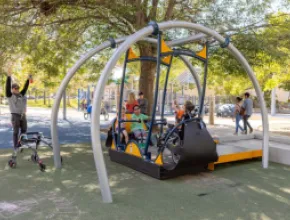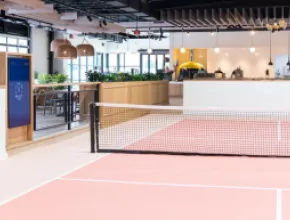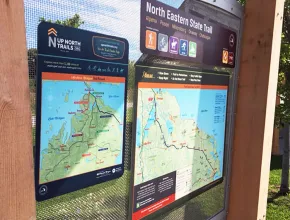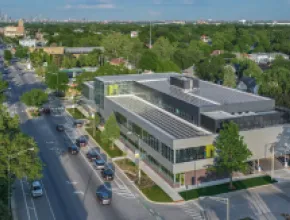
Around 80% of U.S. adults and teens are not sufficiently active, according to a recent study published in JAMA. And physical inactivity is the fourth
|
|
April 29, 2024
Around 80% of U.S. adults and teens are not sufficiently active, according to a recent study published in JAMA. And physical inactivity is the fourth
April 29, 2024
According to the results of the 2023 Industry Report survey, fitness programs were the third most commonly offered program at facilities of all kinds
April 22, 2024
The Florida Swims Foundation and Step Into Swim have joined forces to provide life-saving swim lessons to children throughout Florida.The
April 22, 2024
On Monday, April 15, at Sandstone Ridge Park in North Las Vegas, the U.S. Soccer Foundation opened its 700th mini-pitch—a significant milestone in
April 22, 2024
Bradley Company, the leading source for high-quality locker room equipment, introduces a new collection of
April 22, 2024
Yamaha Motor Corp., USA, announced it will be the exclusive motorized recreation sponsor of the Recreation exhibit at the National Conservation
April 22, 2024
The first-ever attractions industry economic analysis for the Middle East region including several African countries is now unveiled. This
April 22, 2024
When your high school is on the edge of the largest mountain range in North America, you tend to think big, and that’s exactly what Fountain-Fort
April 22, 2024
The most common type of sports-related amenity currently included in the facilities of respondents to the Industry Report survey is outdoor sports
April 17, 2024
On Saturday, April 20, YMCA locations across the country are taking part in the Y’s Healthy Kids Day®, the Y’s nationwide initiative to help build
April 15, 2024
Hayward Holdings, Inc. (NYSE: HAYW) (“Hayward” or the “Company”), a global designer, manufacturer, and marketer of a broad portfolio of pool
April 15, 2024
On March 27, the City of Saraland, Alabama, hosted a groundbreaking ceremony to
April 15, 2024
Royal Caribbean International’s Icon of the Seas is a 20-deck, $2 billion-plus ship that set sail on January 27 from Port Miami with 2,350 crew
April 15, 2024
Ignite Attachments, a breakthrough manufacturer of compact equipment attachments, continues to disrupt
April 15, 2024
Lake Chelan in north-central Washington state is more than 50 miles of crystal clear, glacier-fed lake surrounded by beautiful vineyards, mountains
April 15, 2024
Hybrid cricket pitches have been installed at the Himachal Pradesh Cricket Association (HPCA) Stadium in Dharamshala, the first in what is expected
April 15, 2024
The USA Swimming Foundation awarded $780,000 to 162 swim lesson providers across the country in its initial round of 2024 Learn-to-Swim Grant program
April 15, 2024
The USA Swimming Foundation reports that just one month of formal swimming lessons reduces the risk of drowning by 88%, making learn-to-swim programs
April 09, 2024
SHAPE America – Society of Health and Physical Educators announced its 2024 “Send a Teacher” grant recipients. These four educators, selected from
April 09, 2024
The health and fitness industry is calling on members of Congress and their staff to ignite change and join the fourth annual Congressional Physical
April 09, 2024
Kay Park Recreation Corp., a pioneering manufacturer of outdoor park equipment, proudly announces its 70th anniversary since its inception in 1954.
April 09, 2024
Excel Dryer, the global leader in touchless hand hygiene solutions, recently unveiled a comprehensive
April 09, 2024
Ecore, a company
April 09, 2024
The American College of Sports Medicine® (ACSM) announced the 2023 Paper of the Year for each of its six highly acclaimed journals, including its
April 09, 2024
Hilltip has updated its innovative HTrack™
April 09, 2024
Cyclone Lighting (www.cyclonelighting.com), an established leader in the manufacture of outdoor
April 09, 2024
Pickleball Kingdom, the foremost brand in indoor pickleball franchising, announced commencement of new locations throughout Nebraska, Iowa, and
April 08, 2024
SHAPE America – Society of Health and Physical Educators has announced the release of the new SHAPE America National Physical Education Standards and
April 08, 2024
The percentage of school respondents who report that they have plans for construction has been falling over the past several years, from 69.3% in
April 05, 2024
Kids don’t love staying in one spot. Anyone who has been around children will think that’s an obvious statement, but this is a lesson I learned in

April 04, 2024
There are some who prefer to utilize their leisure time with a little meditative quiet, to decompress and reset by reading a book on a park bench or

April 04, 2024
Technological advances, innovations and analytics are driving the indoor sports surface manufacturing industry, creating multiple buying options for

April 04, 2024
Proper maintenance in aquatic facilities is vitally important to protecting the physical health of users and the financial health of the operators.

April 04, 2024
I recently stopped at a park along a river in my hometown. Upon entering from the parking lot, a sign with vibrant graphics and colors shared rules

April 04, 2024
What does eco-minded recreation facility design have in common with basketball legend LeBron James? Both are focused on conserving as much energy as

April 04, 2024
Kids don’t love staying in one spot. Anyone who has been around children will think that’s an obvious statement, but this is a lesson I learned in

April 04, 2024
Last month, I wrote about the old saw about lions and lambs in March, noting that around here, the month arrived in a decidedly lamblike fashion. We’
April 03, 2024
Durable DockTangent Marine Decking is the durable, low-maintenance marine dock board with exceptional performance and wood-like
April 02, 2024
Problem: How can we offer more play opportunities?SOLUTION: Volo™ is a play-packed structure that soars with fun.
April 02, 2024
A Beacon for Your CommunityStern-Williams offers a solution to help keep parks safe with their Solar Light Option, designed to
April 02, 2024
Incorporated in 1984 by David Park, William Hillman Jr. and Key Ellis, the American Therapeutic Recreation Association (ATRA) is a national
April 02, 2024
Social media and word-of-mouth are popular ways to find out what’s happening in one’s own community, according to the latest National Recreation and
April 02, 2024
USA Swimming announced the addition of two Officials training courses to the online educational platform, USA Swimming University. "Foundations of
April 02, 2024
YMCA's Boys and Young Men of Color (BYMOC) announced a partnership with Old Spice's School of Swagger to help boys of color graduate high
April 02, 2024
Counsilman-Hunsaker, a leading aquatic consulting and engineering firm, announced the appointment of Kevin Post as the new Chairman/CEO and Darren
April 01, 2024
Fluidra, a leading global provider of residential and commercial pool and wellness equipment, has been recognized by the U.S. Environmental
April 01, 2024
Pentair (NYSE: PNR), a leader in helping the world sustainably move, improve, and enjoy water, is honored to receive the 2024 ENERGY STAR® Partner of
April 01, 2024
JLG Architects has announced three strategic moves to expand the footprint of its national Sports Studio. A new hire and two principal promotions
April 01, 2024
The Department of the Interior announced the selection of 14 projects in 11 states to receive $58.3 million through the National Park Service’s
April 01, 2024
The 2023 Walmart NW Arkansas Championship presented by P&G was recently named a GEO Certified® Sustainable Golf Tournament, designating the event
April 01, 2024
The Dallas Parkand Recreation Department and Fair Park First have
April 01, 2024
New peer-reviewed research from the American Society of Landscape Architects (ASLA) Fund demonstrates how landscape architecture solutions can help
April 01, 2024
Respondents to the Industry Report Survey from parks and camp facilities were the most likely to indicate both that they were involved in
March 27, 2024
Rock Around the Hawk, an immersive recreation program in Farmington Hills, Mich., for toddler and preschool-aged children and their caregivers, was
March 27, 2024
By Alyssa Smith, Madeline Dodenhoff & Peter J. Titlebaum, Ed.D. LinkedIn should be on a student’s regular social media rotation, so
March 25, 2024
Connected walking and biking infrastructure will provide equitable access and opportunity to communities across the country with projects funded by
March 25, 2024
While less than half (46.4%) of all respondents to the Industry Report survey in 2023 said they currently include walking and hiking trails at their
March 25, 2024
The Senate Budget Committee held a hearing on “Recreation at Risk: The Nature of Climate Costs,” spotlighting the impacts of climate change on
March 25, 2024
Keep America Beautiful® officially kicked off its 2024
March 25, 2024
The alignment between SB 544 and the "Every Child A Swimmer" legislation and program emphasizes a shared commitment to protecting Florida's children
March 25, 2024
What happens when two friends strike out on their own to start a company? They work hard, have fun, and grow into one of the largest and most
March 25, 2024
Bobcat Company (Bobcat), a global equipment,
March 25, 2024
In a dynamic era where technology continues to revolutionize the health and fitness industry, the
March 25, 2024
Bedford Reinforced Plastics — a full-service supplier offering an extensive line of
March 25, 2024
IAAPA, the global association for the attractions industry, announced a new partnership with
March 25, 2024
The Association of Pickleball Players (APP), the American Cancer Society and UTR Sports are teaming up to fight cancer through Doubles Dink for
March 25, 2024
The International Swimming Hall of Fame, in collaboration with the Princess Charlene of Monaco Foundation, is proud to announce the launch of the
March 25, 2024
The Rube Goldberg Institute, a family-run nonprofit that uses
March 22, 2024
Colorado Time Systems, a PlayCore company is pleased to be an object donor to this family friendly, interactive exhibition focused on the
March 18, 2024
The 2024 IHRSA Convention & Trade Show wrapped with buzz about the organization's new name launch and targeted mission to be the global community
March 18, 2024
American Hiking Society is pleased to announce the 2024 class of NextGen Trail Leaders
March 18, 2024
The Health & Fitness Association (formerly IHRSA), a global community of industry leaders, elected five new board members on March 8 at its
March 18, 2024
The American Society of Landscape Architects (ASLA) Fund has released new peer-reviewed research on landscape architecture solutions to extreme heat
March 18, 2024
The Health & Fitness Association (formerly IHRSA), a global community of industry leaders, honored three industry leaders with awards at its
March 18, 2024
Every one of the seven major sport and fitness physical activity categories showed increased year-over-year rates of participation, according to the
March 18, 2024
Respondents to the Industry Report survey from schools and Ys were the most likely to offer youth sports programming at their facilities, while those
March 15, 2024
The DOGIPOT® concept was created to solve the growing problem of dog pollution. An estimated 90 million dogs are in the U.S., equivalent to nearly 8

March 13, 2024
National Park Trust is pleased to announce the 2024 grantees of the Every Kid Outdoors Small Grants Program. In partnership with the USDA Forest
March 13, 2024
The U.S. Department of Agriculture announced nearly $66 million to improve water quality, roads, trails, bridges and fish habitat on national forests
March 13, 2024
The Outdoor Recreation Roundtable (ORR) applauds the markup of the Economic Development Reauthorization Act of 2024, which has a historic focus on
|
|